2015-2020 MAGNIFICENT LIFE by CIT Coin Invest
Released back in 2007, alongside the superb Evolution of Life series, Magnificent Life took a wholly different approach to the one-ounce coin. Eschewing the antique finish and rose-gold gilding of its prehistoric-themed sibling, this series went with a deep strike (a concave dish on the reverse face), a proof finish and varying amounts of colouration. Smartminting was in evidence, in this case allowing highly defined levels of subtle high-relief.
The key to the look of these isn’t just down to the strike, but also to the high quality of the colouration. Many mints use a low-res application that close-up looks like newsprint, with that old ‘dot-matrix’ look. In reality, that is less noticeable in hand, because the coin may only be sub-40mm in diameter, but that doesn’t mean a higher resolution doesn’t bring benefits. When you have high-relief, especially with smartminting’s knack of sharp definition, high-resolution colour is able to follow that detail better, while offering a wider colour gamut and a richer application. As you can see from the coin images here, the end result is excellent.
The 2020 coin features the Chameleon, but there have been entrants from the bird, reptile, amphibian and arachnid worlds, although strangely enough, no mammals or fish. Whatever the choices, there are no poor designs here, with the latter trio in particular raising the bar. Coloured proof coins are a staple of the modern collectible coin world, but they’re rarely done as well as they are here. No minigold variants, as CIT so often do with their major series, and packaging is standard CIT fare (good quality). A shame to see this series end, but it leaves a fine legacy and remains a very attractive series.
2015 PEACOCK
Peacocks are members of the pheasant family and are relatively large and very colourful birds widely lauded for their distinctive, iridescent tails. The tail feathers are known as ‘coverts’ and can exceed 60% of the birds overall length when they’re fully deployed. As for the use of the tail feathers, it’s for the ladies, who choose their mates based on how spectacular the displays are.
While the name ‘peacock’ is used for the birds, the correct name is Peafowl, with peacock being the term used for male birds, and peahen for females. A male may maintain a ‘harem’ of several females, who often roost in trees. They gather in groups called ‘parties’.
The animal on the coin is a Blue, or Indian Peafowl, native to India and Sri Lanka. A common site around the world, as they’re kept as pets on large estates, although they are quite a bad tempered bird that doesn’t mix well. So, we have a bird where the females choose their mate using superficial criteria, that think they’re better than other birds, and hang around in parties. We’re beginning to think one of these would do great on Instagram…
2016 WASP SPIDER
A species of the widely spread orb-web spider, the pretty Wasp Spider (Argiope bruennichi) can be found from North Africa to Northern Europe, and around some parts of Asia. Named for its striking appearance, likely designed to ward of predators, the Wasp Spider builds a spiral orb web in which it catches its prey.
A web will typically take around an hour to spin and is generally placed in grass, just above ground level. The unusual zigzag shape, called the stabilimentum, maybe there to attract insects. Those insects unfortunate to fly into the web are quickly immobilised with silk and then bitten and injected with a paralysing venom and a protein-dissolving enzyme. It’s a kind of instant soup mix.
Being a male Wasp Spider is no walk in the park, with males averaging around 4.5 mm in length and females closer to 15 mm. They practice cannibalism after mating, and extensively so. Some males wait until the female has just moulted, and her mouthparts are soft, in the hopes of getting a quickie without ending up on the menu. We guess, if you’re going to go, however, after sex is as good a time as any…
2017 COBRA
The Indian cobra (Naja naja) is found in the Indian subcontinent (India, Pakistan, Bangladesh, Sri Lanka, Nepal) and is a member of the “big four” species that inflict the most snakebites on humans in India, along with the Common krait, Russell’s viper and Saw-scaled viper. This snake is revered in Indian mythology and culture, and is often seen with snake charmers. It is now protected in India under the Indian Wildlife Protection Act (1972).
It is a moderately sized, heavy bodied species, easily identified by its relatively large and quite impressive hood, which it expands when threatened. This species has a head which is elliptical, depressed, and very slightly distinct from neck. The snout is short and rounded with large nostrils. The eyes are medium in size and the pupils are round. The majority of adult specimens range from 1 to 1.5 metres in length. Some specimens, particularly those from Sri Lanka, may grow to lengths of 2.1 to 2.2 metres, but this is relatively uncommon, fortunately.
The Indian cobra’s venom mainly contains a powerful post-synaptic neurotoxin and cardiotoxin. The venom acts on the synaptic gaps of the nerves, thereby paralyzing muscles, and in severe bites leading to respiratory failure or cardiac arrest. The venom components include enzymes such as hyaluronidase that cause lysis and increase the spread of the venom. Symptoms may manifest between 15 minutes and 2 hours following the bite.
The snake inhabits a wide range of habitats throughout its geographical range. It can be found in dense or open forests, plains, agricultural lands (rice paddy fields, wheat crops), rocky terrain, wetlands, and it can even be found in heavily populated urban areas such as villages and city outskirts, ranging from sea-level to 2,000 metres in altitude. This species is absent from true desert regions, but is often found in the vicinity of water. Preferred hiding locations are holes in embankments, tree hollows, termite mounds, rock piles and small mammal dens.
2018 TREE FROG
A thoroughly iconic creature, the Red-eyed Treefrog (Agalychnis callidryas)is a gorgeous example of biodiversity. Native to the rainforests of the Central American region, it inhabits areas near rivers and ponds in rainforests, and humid lowlands. They are also popularly kept in captivity. They have red eyes with vertically narrowed pupils. It has a vibrant green body with yellow/ blue vertically striped sides. Its webbed feet and toes are orange or red. The scientific name of the red-eyed tree frog, A. callidryas, comes from Greek words kalos (beautiful) and dryas (a tree or wood nymph). Red-eyed tree frogs have sticky pads on their toes to cling onto leaves.
The Red-eyed Treefrog is an arboreal creature, spending its life jumping around trees, remaining mainly motionless in the daylight hours. With its bright parts covered, it blends into the vegetation exceptionally well, but will open its eyes suddenly if disturbed. The sudden appearance of two big red eyes is often enough to startle a potential predator long enough for the frog to hop off.
Living for around five years, they begin to mate from around three years of age, laying eggs which hatch after six to seven days that develop into tadpoles. Red-eyed treefrogs are insectivores, eating crickets, moths, grasshoppers, flies, and other insects. Fortunately, they are classified as being of Least Concern, although deforestation remains an issue.
2019 PHILIPPINE EAGLE
The Philippine eagle (Pithecophaga jefferyi), also known as the monkey-eating eagle, is endemic to forests in the Philippines. It has brown and white-coloured plumage, and a shaggy crest, and generally measures 86 to 102 cm in length and weighs 4.7 to 8.0 kilograms. It’s considered the largest of the extant eagles in the world in terms of length, with only the Steller’s sea eagle and the Harpy eagle being having more heft. Among the rarest and most powerful birds in the world, it has been declared the Philippine national bird. It is critically endangered, mainly due to massive loss of habitat due to deforestation in most of its range. Killing a Philippine eagle is punishable under Philippine law by 12 years in jail and heavy fines.
Prey specimens found at the eagle’s nest have ranged in size from a small bat weighing 10 g to a Philippine deer weighing 14 kg. The primary prey varies from island to island depending on species availability, particularly in Luzon and Mindanao, because the islands are in different faunal regions. For example, the tree squirrel-sized Philippine flying lemurs, the preferred prey in Mindanao, are absent in Luzon. The primary prey for the eagles seen in Luzon are monkeys, birds, flying foxes, giant cloud-rats, which can weigh twice as much as flying lemurs at 2 to 2.5 kg, and reptiles such as large snakes and lizards.
Philippine eagles primarily use two hunting techniques. One is still-hunting, in which it watches for prey activity while sitting almost motionlessly on a branch near the canopy. The other is perch-hunting, which entails periodically gliding from one perch to another. While perch-hunting, they often work their way gradually down from the canopy on down the branches and, if not successful in find prey in their initial foray, will fly or circle back up to the top of the trees to work them again. (Wikipedia)
2020 CHAMELEON
Chameleons are a distinctive and highly specialized clade of Old World lizards, with 202 species described as of June 2015. These species come in a range of colours, and many species have the ability to change colour, something which has become the signature feature of these popular animals. Different chameleon species are able to vary their colouration and pattern through combinations of pink, blue, red, orange, green, black, brown, light blue, yellow, turquoise, and purple. Chameleon skin has a superficial layer which contains pigments, and under the layer are cells with guanine crystals. Chameleons change colour by changing the space between the guanine crystals, which changes the wavelength of light reflected off the crystals, which changes the colour of the skin.
Chameleons are distinguished by their zygodactylous feet; their very extensive, highly modified, rapidly extrudable tongues; their swaying gait; and crests or horns on their brow and snout. Most species, the larger ones in particular, also have a prehensile tail. Chameleons’ eyes are independently mobile, but in aiming at a prey item, they focus forward in coordination, affording the animal stereoscopic vision.
Chameleons are adapted for climbing and visual hunting. They live in warm habitats that range from rain forest to desert conditions, with various species occurring in Africa, Madagascar, southern Europe, and across southern Asia as far as Sri Lanka. They’ve also been introduced to Hawaii, California, and Florida, and often are kept as household pets. (Wikipedia)
SPECIFICATION
| MAGNIFICENT LIFE | |
| DENOMINATION | $5 CID (Cook Islands) |
| COMPOSITION | 0.999 silver |
| WEIGHT | 31.1 grams |
| DIMENSIONS | 38.61 mm |
| FINISH | Proof |
| MODIFICATIONS | Colour, Smartminting, concave face |
| MINTAGE | 999 |
| BOX / C.O.A. | Yes / Yes |




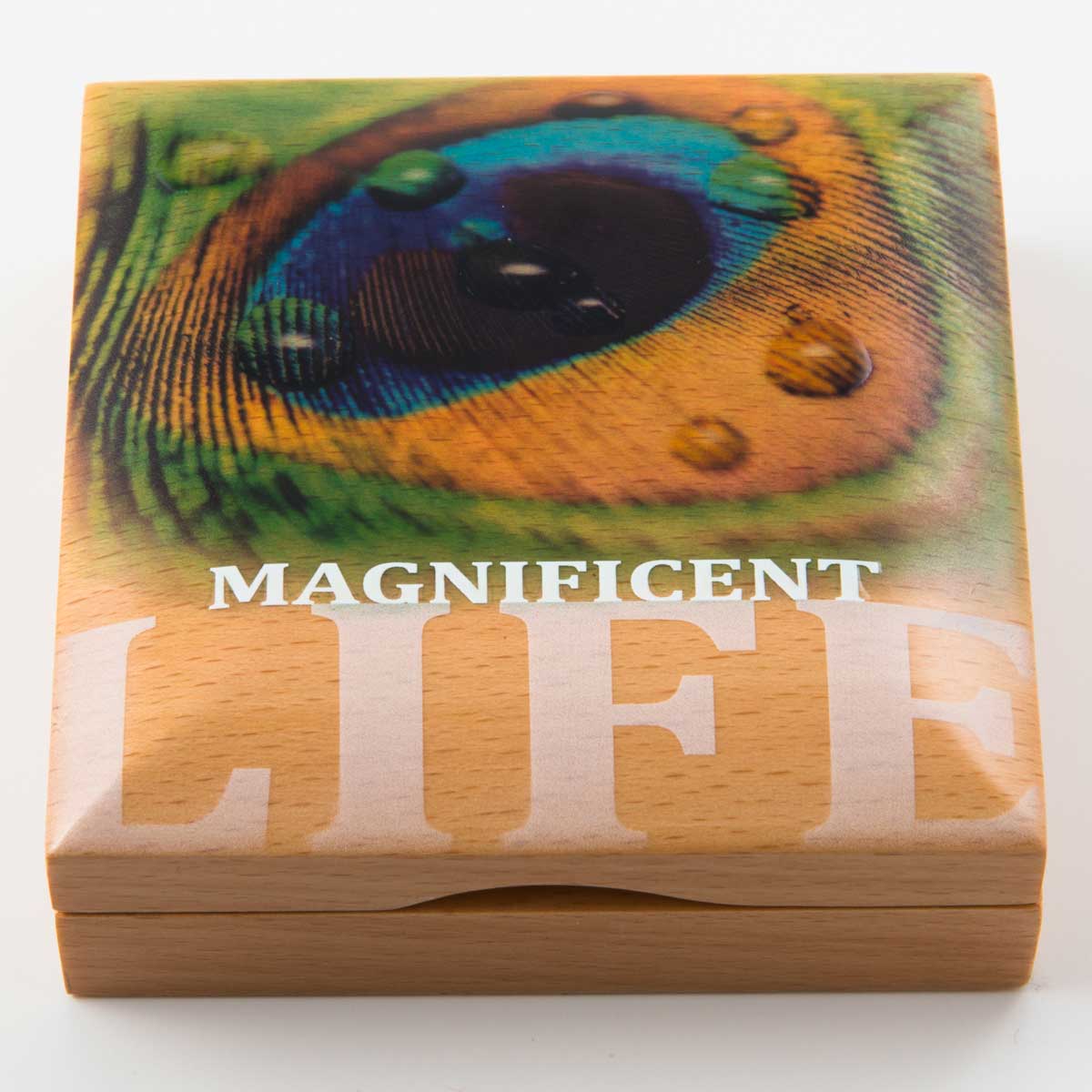

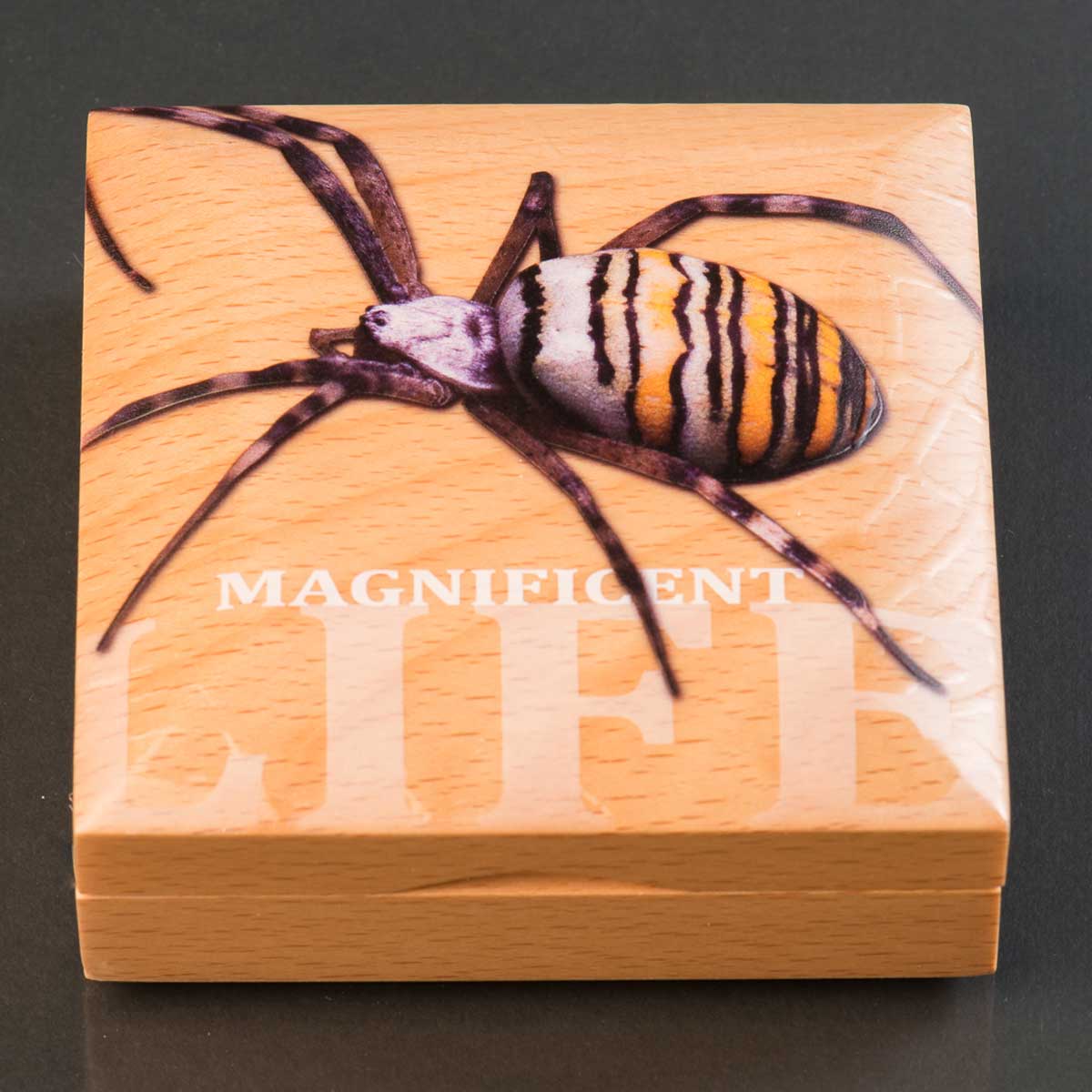

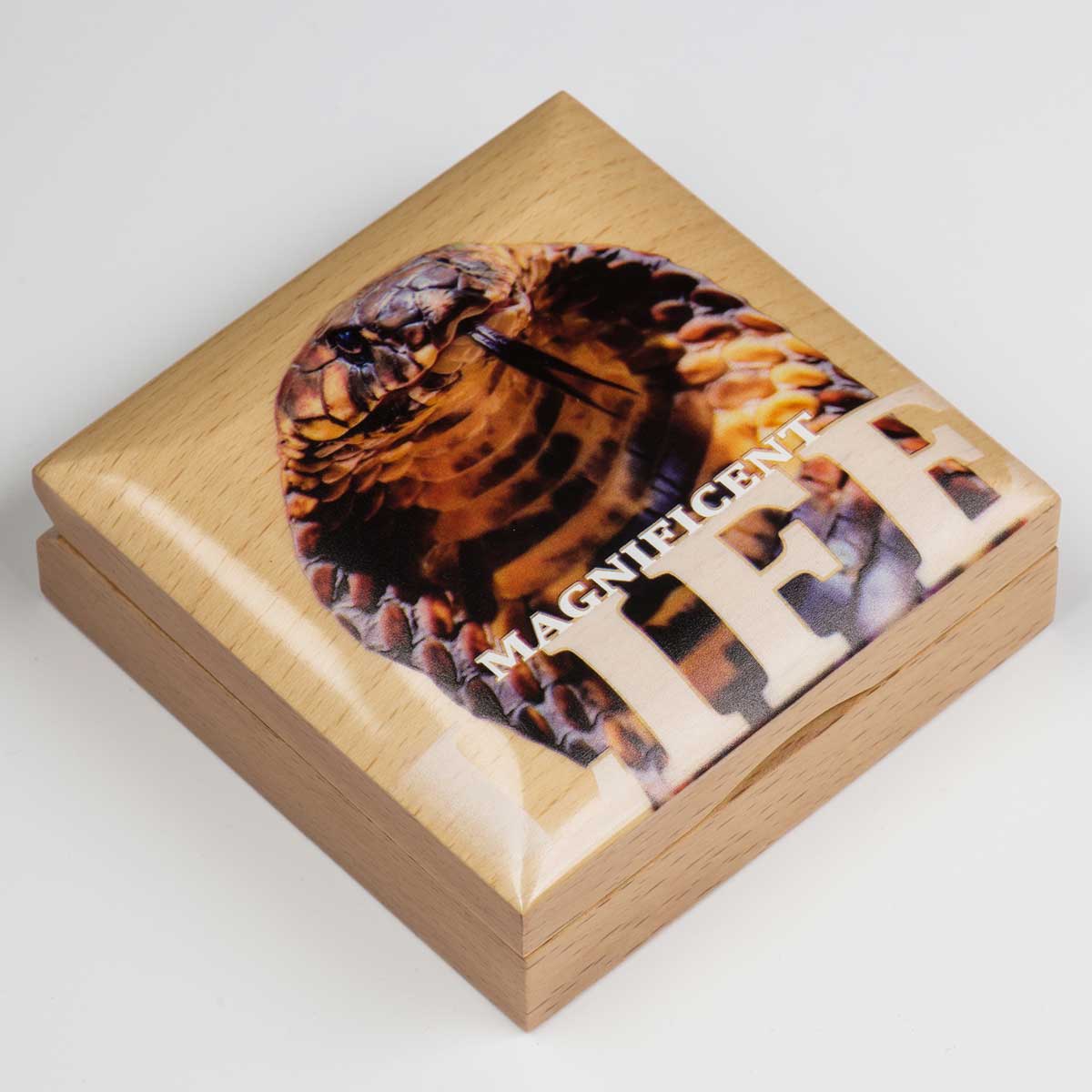
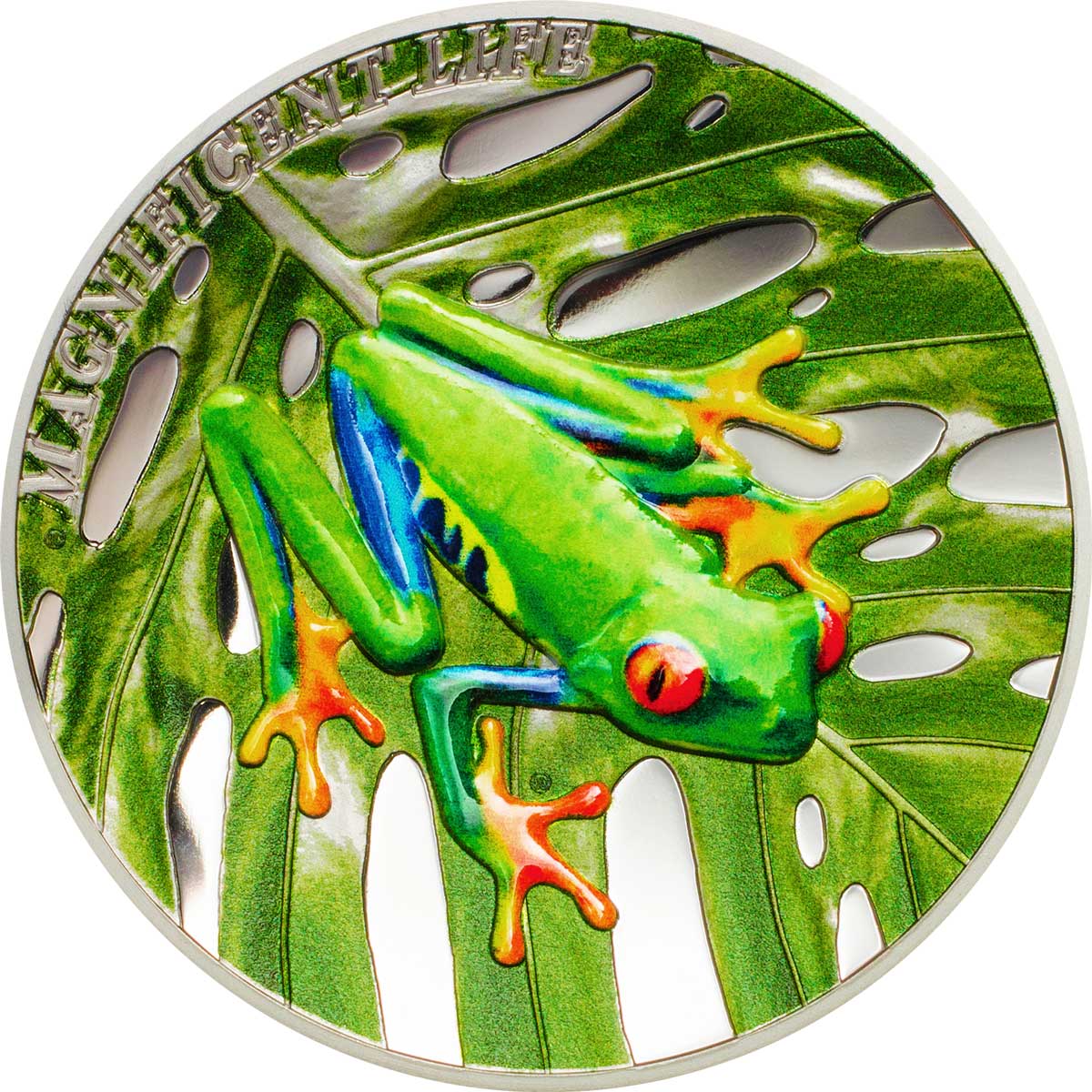
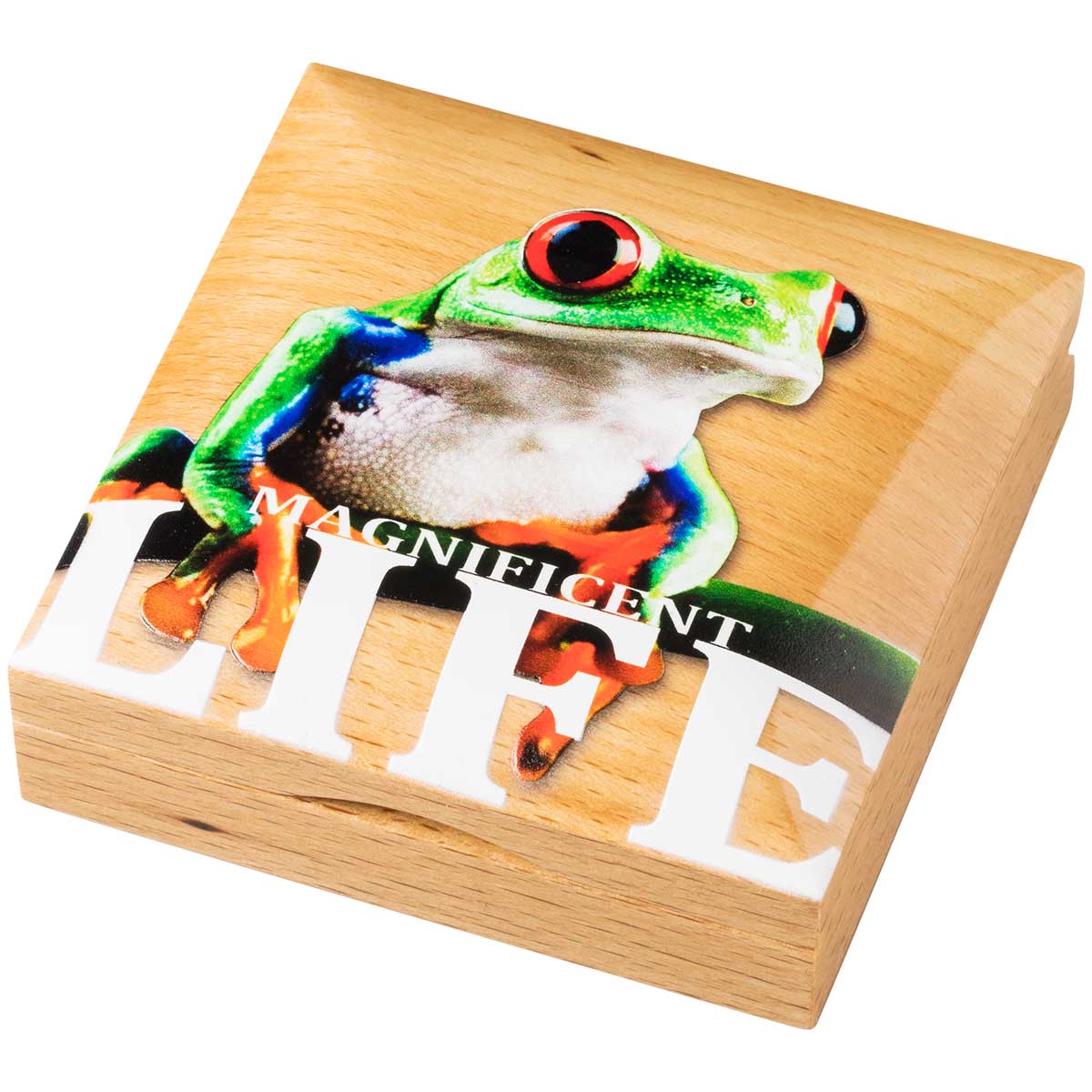

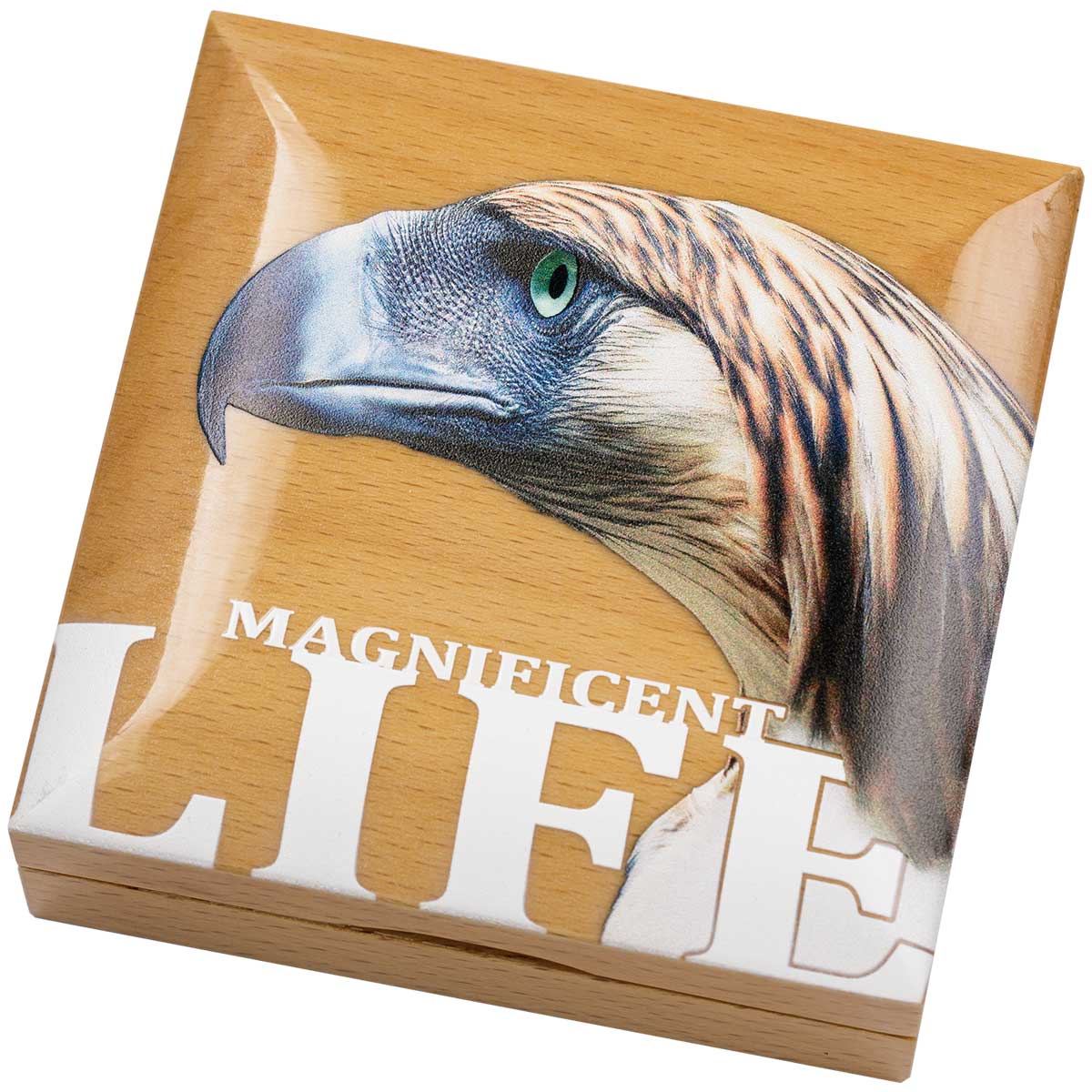

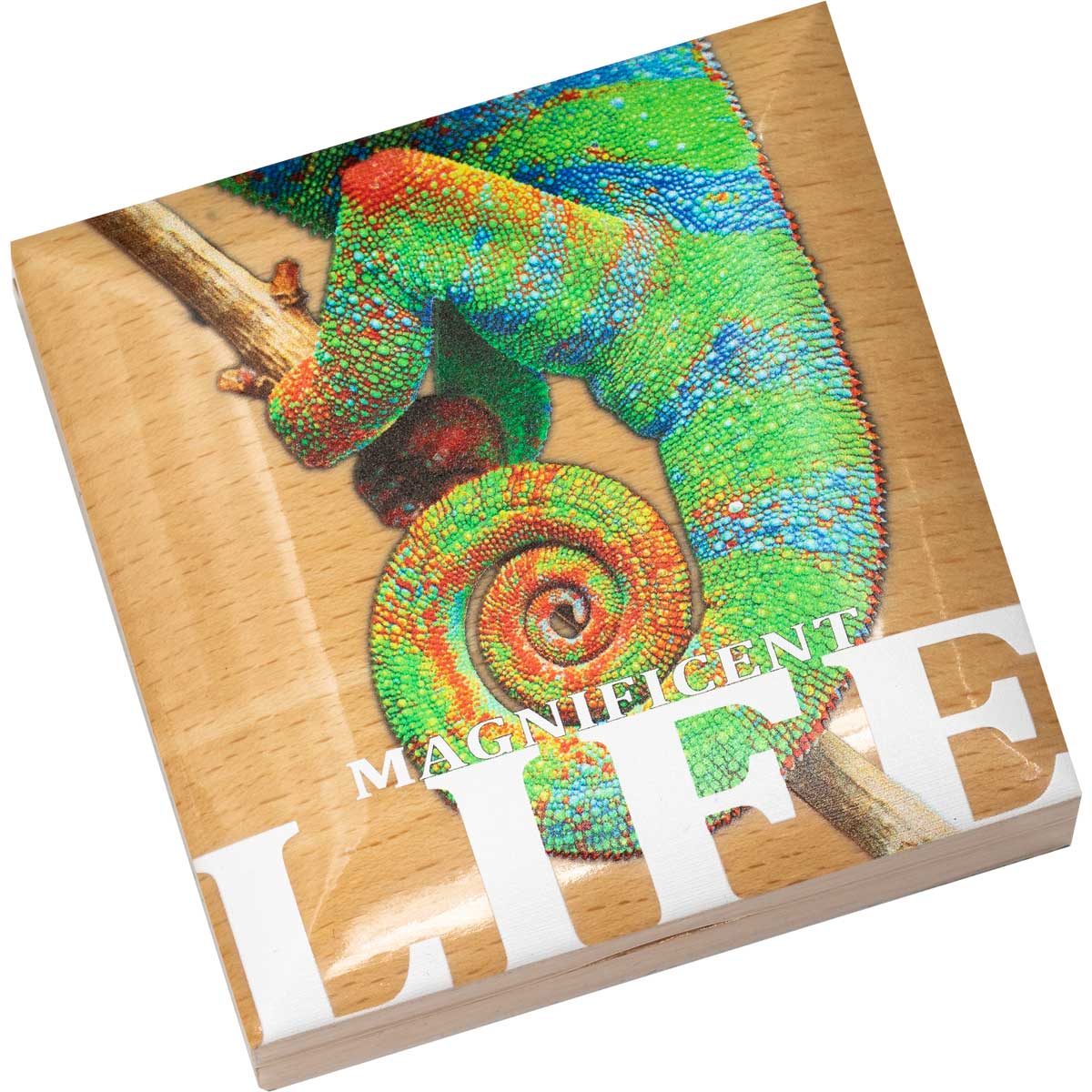

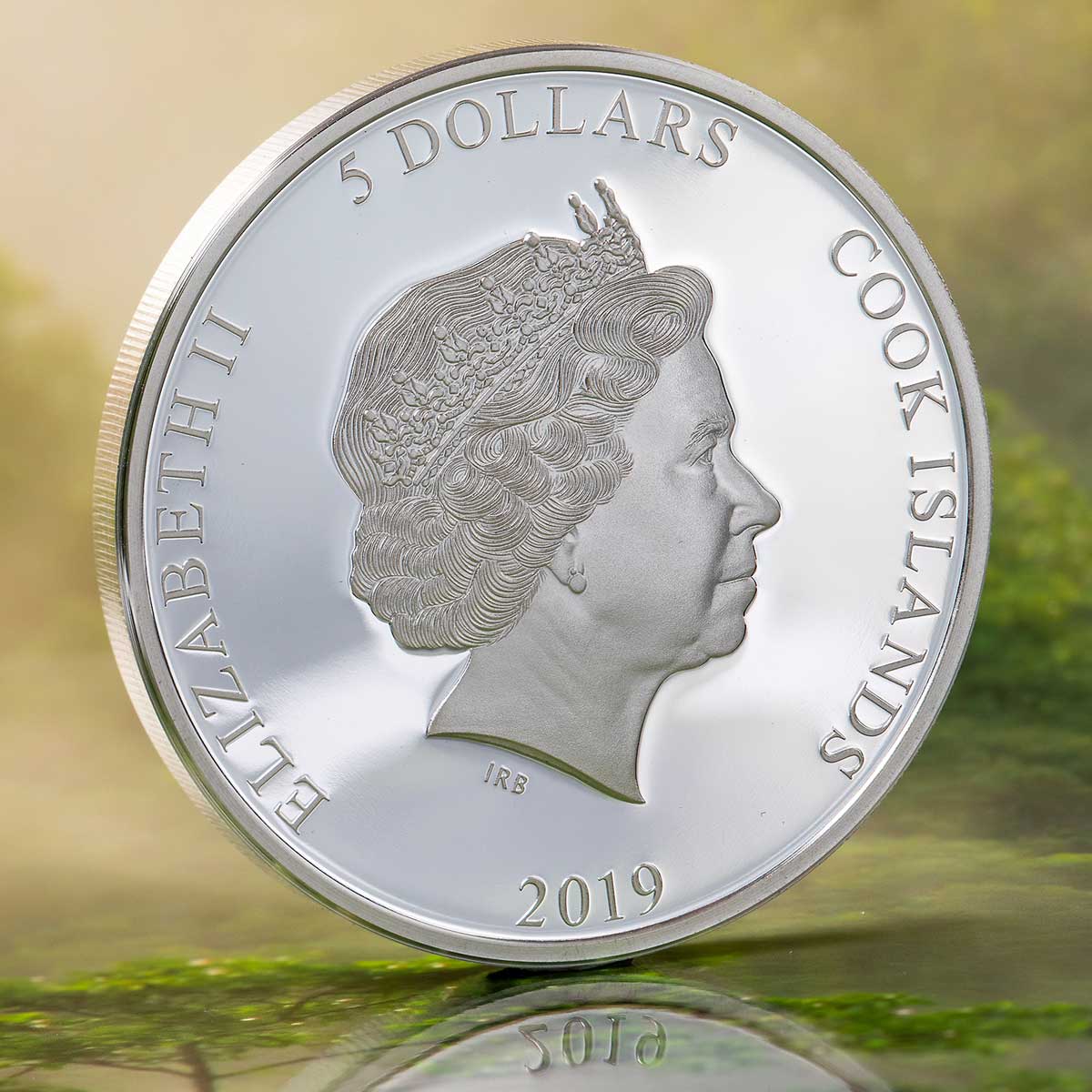
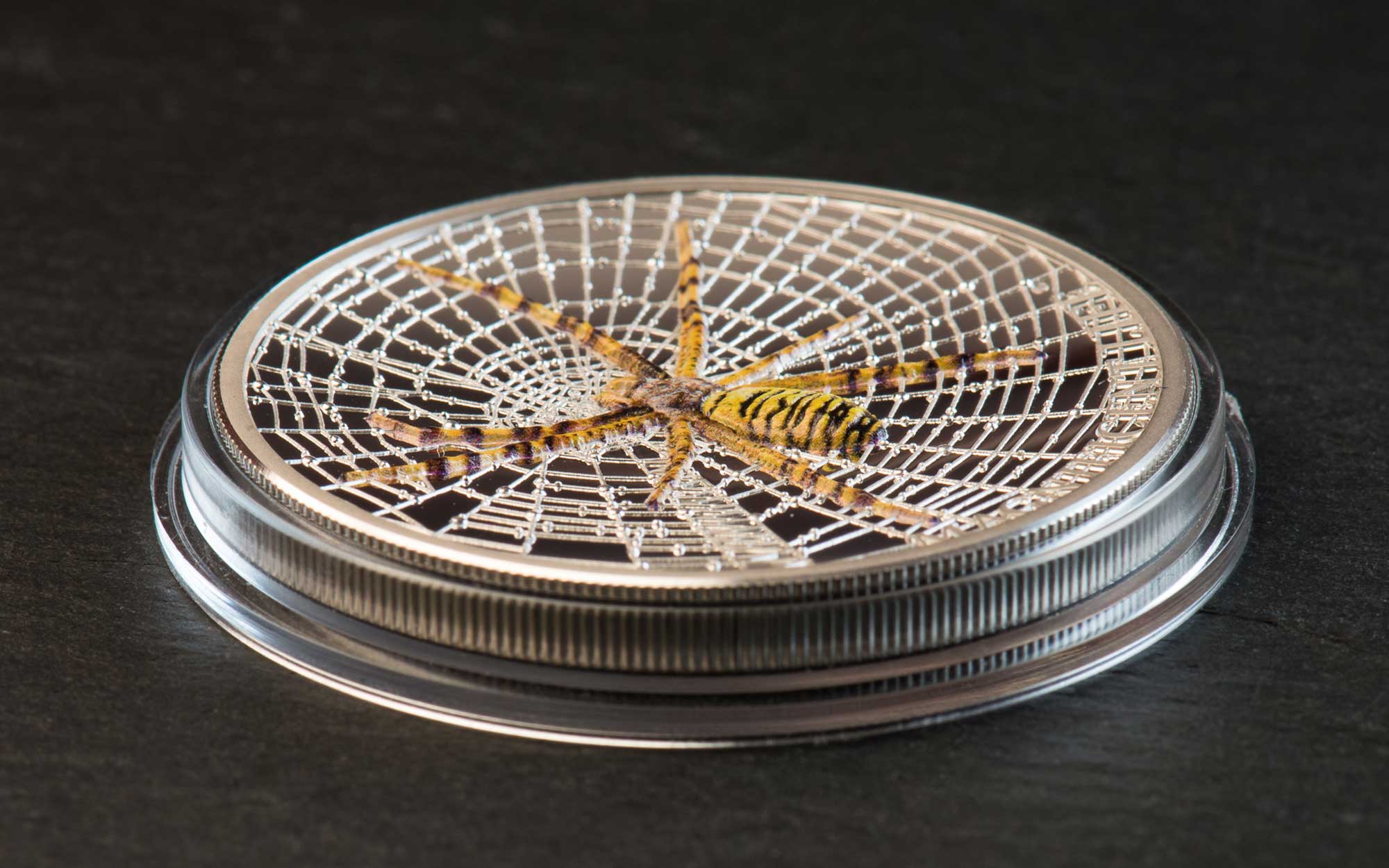


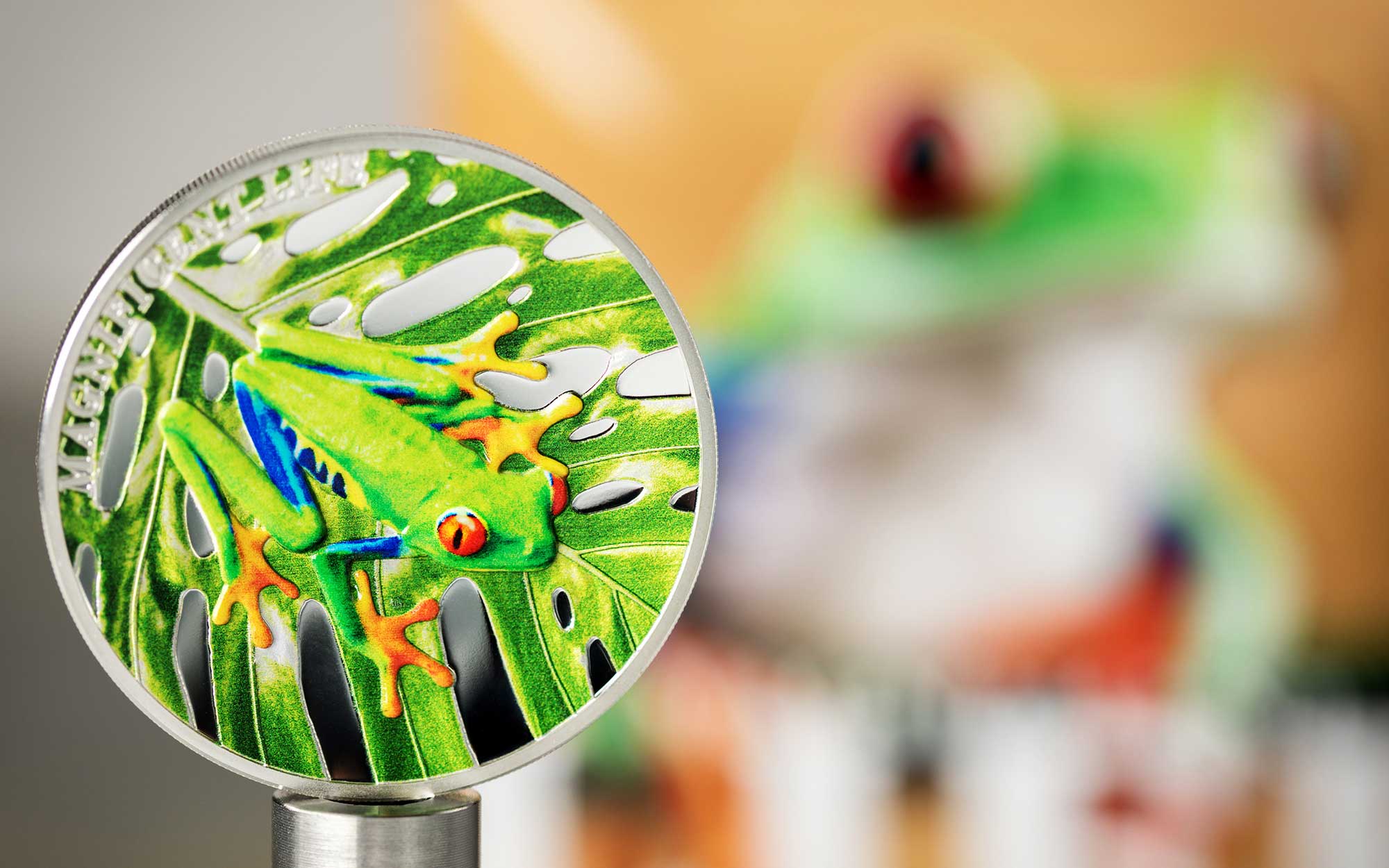



Leave A Comment